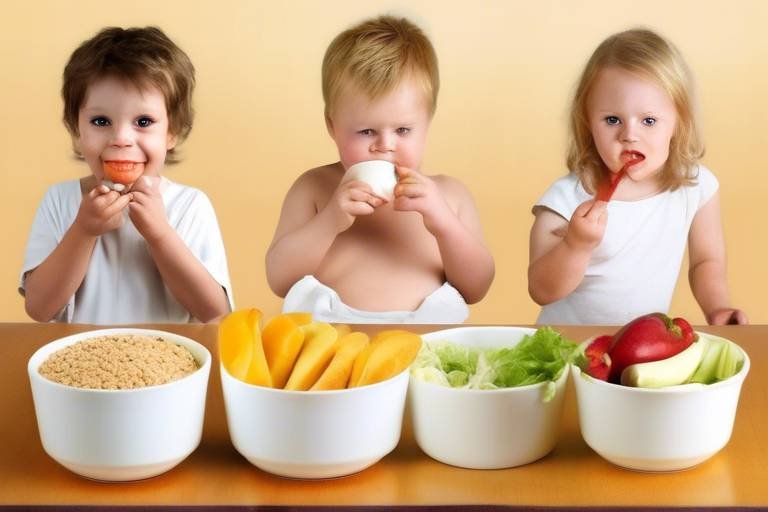Understanding the Role Nutrition Plays in Your Child's Development
Nutrition is more than just a buzzword; it’s the cornerstone of your child's growth and development. Imagine your child as a little sapling; without the right nutrients, it simply can't thrive. From the moment they take their first breath, the food they consume plays a crucial role in shaping their physical and mental well-being. A well-balanced diet not only fuels their bodies but also boosts their cognitive functions, helping them excel in school and social interactions. So, as a parent, how can you ensure that your child is getting the nutrition they need? Let's dive into the vital aspects of nutrition that can set your child on a path to healthy growth and development.
Balanced nutrition is like a well-tuned orchestra, where every nutrient plays its part in creating a beautiful symphony of health. Children need a variety of nutrients to support their physical and mental development. These nutrients provide the necessary energy for play, learning, and growth, while also strengthening their immune systems. Think of nutrition as the foundation of a house; without a solid base, everything else is at risk. A well-rounded diet sets the stage for a lifetime of healthy habits, making it essential for parents to understand the importance of balanced nutrition.
During childhood, certain nutrients take center stage in promoting growth and development. Key vitamins and minerals, such as calcium, iron, and vitamins A and D, play pivotal roles in building strong bones, enhancing cognitive functions, and supporting overall health. For instance, calcium is crucial for bone density, while iron is essential for cognitive development. When your child consumes a variety of foods rich in these nutrients, they are not just filling their stomachs; they are fueling their futures. Here's a quick look at some essential nutrients:
| Nutrient | Role in Development | Food Sources |
|---|---|---|
| Calcium | Supports bone growth | Dairy products, leafy greens |
| Iron | Enhances cognitive function | Red meat, beans, fortified cereals |
| Vitamin A | Promotes vision and immune function | Carrots, sweet potatoes, spinach |
| Vitamin D | Facilitates calcium absorption | Fatty fish, fortified milk, sunlight |
When it comes to building and repairing tissues, protein is the superhero nutrient. Adequate protein intake is essential for muscle growth and overall physical development in children. Just like a bricklayer needs bricks to build a strong wall, children need protein to build strong muscles and tissues. Without enough protein, your child may feel sluggish and less energetic. So, how can you ensure your child is getting enough protein in their diet?
Identifying healthy protein sources is crucial for parents. Here are some excellent options:
- Plant-based proteins: Lentils, chickpeas, and quinoa.
- Lean meats: Chicken, turkey, and fish.
- Dairy products: Yogurt, cheese, and milk.
Children's protein requirements vary by age, just like their growth spurts. For example, toddlers need around 13 grams of protein daily, while teenagers may require up to 52 grams. Understanding these needs can help parents ensure their children are getting enough of this vital nutrient. Here's a quick breakdown:
| Age Group | Recommended Daily Protein Intake |
|---|---|
| 1-3 years | 13 grams |
| 4-8 years | 19 grams |
| 9-13 years | 34 grams |
| 14-18 years | 46-52 grams |
Did you know that healthy fats are just as important for your child's brain development as proteins? These fats play a significant role in cognitive abilities and emotional well-being. Think of healthy fats as the oil that keeps the engine running smoothly. They help in the formation of brain cells and are crucial for memory and concentration. Foods rich in omega-3 fatty acids, such as fish, walnuts, and flaxseeds, can significantly enhance brain function in your child.
Proper hydration is often overlooked in children's nutrition. Just like a plant needs water to flourish, your child needs adequate fluid intake to maintain energy levels and cognitive function. Water is essential for digestion, nutrient absorption, and even temperature regulation. Encouraging your child to drink water regularly, especially during physical activities, can make a world of difference in their overall health.
Recognizing the signs of dehydration is crucial for parents. Common symptoms include:
- Dry mouth and throat
- Fatigue and dizziness
- Dark-colored urine
By keeping an eye out for these symptoms, you can ensure that your child stays hydrated throughout the day.
Fostering healthy eating habits from an early age is essential. It’s not just about what your child eats but how they eat. Here are some practical tips for parents:
- Meal planning: Involve your children in planning meals to make them more excited about healthy eating.
- Cooking together: Get your kids involved in the kitchen; it’s a fun way to teach them about nutrition.
- Positive food environment: Create a positive atmosphere around meals to encourage open-mindedness about trying new foods.
By nurturing these habits, you can help your child develop a healthy relationship with food that lasts a lifetime.
Q: What are the best snacks for children?
A: Healthy snacks include fruits, vegetables with hummus, yogurt, and whole-grain crackers. These options provide essential nutrients without added sugars.
Q: How can I get my picky eater to try new foods?
A: Try introducing new foods gradually and make them fun! Involve your child in cooking and let them choose what to try.
Q: How much water should my child drink daily?
A: Generally, children should drink about 5-7 cups of water a day, but this can vary based on activity level and climate.
Q: Are vitamins necessary for my child?
A: While a balanced diet is usually sufficient, some children may benefit from vitamins, especially if they have dietary restrictions. Always consult a pediatrician.

The Importance of Balanced Nutrition
Balanced nutrition is not just a buzzword; it’s a fundamental pillar for children's physical and mental development. Think of it as the fuel that powers a high-performance engine. Just like a car needs the right kind of fuel to run smoothly, children require a balanced diet to thrive. Without the right nutrients, their growth can be stunted, and their cognitive abilities may not reach their full potential. A well-rounded diet provides the necessary energy and nutrients for growth, immune function, and cognitive abilities, setting the foundation for a healthy future.
Imagine a child’s body as a complex construction site. Each nutrient acts like a different type of worker, contributing to the building process. For instance, proteins are the builders, carbohydrates provide the energy needed to keep the workers going, and vitamins and minerals are the tools that ensure everything is done correctly. When these components are in harmony, the result is a well-built structure—our children’s bodies and minds.
Moreover, a balanced diet helps in regulating metabolism, maintaining a healthy weight, and preventing chronic diseases later in life. It’s not just about what they eat today; it’s about laying the groundwork for their future. Children who develop healthy eating habits early on are more likely to carry those habits into adulthood, reducing their risk of obesity, diabetes, and heart disease.
To give you a clearer picture, here’s a simple breakdown of what a balanced plate might look like for children:
| Food Group | Examples | Recommended Portion |
|---|---|---|
| Fruits | Apples, bananas, berries | 1-2 servings daily |
| Vegetables | Carrots, spinach, broccoli | 1-2 servings daily |
| Grains | Whole wheat bread, brown rice | 3-6 servings daily |
| Protein | Chicken, beans, nuts | 2-3 servings daily |
| Dairy | Milk, yogurt, cheese | 2-3 servings daily |
As you can see, achieving a balanced diet involves a variety of food groups. It’s essential for parents to encourage their children to try different foods, as this not only helps in meeting their nutritional needs but also makes meals more enjoyable. Engaging children in the cooking process can spark their interest in different foods, making them more likely to eat a variety of healthy options.
In conclusion, balanced nutrition is a critical aspect of child development that cannot be overlooked. It provides the building blocks for a healthy body and mind, ensuring that children grow up strong, healthy, and ready to take on the world. Remember, nutrition is not just about feeding children; it’s about nourishing their potential.

Essential Nutrients for Growth
When it comes to your child's growth, nutrition acts like the fuel that powers a high-performance engine. Just as a car needs the right kind of fuel to run efficiently, children require a variety of essential nutrients to support their physical and mental development. These nutrients are like building blocks, each playing a unique role in ensuring that your child not only grows but thrives.
Among these vital nutrients, calcium stands out as a superstar. It is crucial for developing strong bones and teeth, which is especially important during the rapid growth phases of childhood. Think of calcium as the scaffolding for a building; without it, the structure would be weak and unstable. Foods rich in calcium include dairy products like milk and yogurt, leafy greens, and fortified cereals. Ensuring your child gets enough calcium can help prevent issues like osteoporosis later in life.
Another key player in the nutrition game is iron. This mineral is essential for the production of hemoglobin, which carries oxygen in the blood. Without adequate iron, children may experience fatigue and decreased cognitive function, making it harder for them to concentrate at school. Iron-rich foods include red meat, beans, lentils, and fortified cereals. It's important to pair these with vitamin C-rich foods like oranges or strawberries to enhance iron absorption.
Vitamins are also critical for growth, particularly vitamin A and vitamin D. Vitamin A is vital for vision, immune function, and skin health, while vitamin D plays a crucial role in calcium absorption and bone health. You can find vitamin A in foods like carrots, sweet potatoes, and spinach, while vitamin D is available through sunlight exposure and foods like fatty fish and fortified milk.
To give you a clearer picture of these essential nutrients, here’s a quick overview of their roles:
| Nutrient | Role in Growth | Food Sources |
|---|---|---|
| Calcium | Supports bone and teeth development | Dairy products, leafy greens, fortified cereals |
| Iron | Essential for oxygen transport in blood | Red meat, beans, lentils, fortified cereals |
| Vitamin A | Important for vision and immune function | Carrots, sweet potatoes, spinach |
| Vitamin D | Crucial for calcium absorption and bone health | Fatty fish, fortified milk, sunlight |
Incorporating these nutrients into your child's diet doesn’t have to be a chore. You can make it fun and engaging! For example, consider involving your child in meal planning and preparation. Let them pick out colorful fruits and vegetables at the grocery store, or have them help you cook a nutritious meal at home. This not only teaches them about healthy eating but also makes them more likely to try new foods.
Ultimately, ensuring that your child receives a balanced diet filled with these essential nutrients is a gift that will keep on giving throughout their life. It sets the stage for not just physical health but also cognitive development, emotional well-being, and a strong immune system. So, as a parent, take the time to educate yourself and your child about the importance of nutrition; it's an investment in their future.

Protein and Muscle Development
Protein is often dubbed the building block of life, and when it comes to children, this statement couldn't be more accurate. During childhood, their bodies are in a constant state of growth and development, making adequate protein intake crucial for not just muscle development but also for overall health. Think of protein as the foundation of a house; without a strong base, everything else can crumble. Children need protein to repair tissues, produce enzymes and hormones, and support immune function. The right amount of protein can help children build strong muscles, which is essential for their physical activities and overall strength.
When we talk about muscle development, it's important to understand how protein works in the body. When children consume protein, it's broken down into amino acids, which are then used to build and repair muscles. This is especially important for active children who engage in sports or physical play. Imagine their muscles as sponges soaking up all the goodness from protein; the more they have, the stronger and more resilient they become. But how much protein do they actually need? Well, that can vary based on their age, activity level, and individual growth patterns.
For parents, knowing the recommended daily allowance (RDA) for protein can help ensure that their children are meeting their nutritional needs. According to dietary guidelines, children aged 1-3 years need about 13 grams of protein per day, while those aged 4-8 years require approximately 19 grams. As children grow into their teenage years, their protein needs increase significantly, with adolescents needing anywhere from 34 to 52 grams per day, depending on their age and sex. Here’s a simple table to illustrate these needs:
| Age Group | Daily Protein Requirement (grams) |
|---|---|
| 1-3 years | 13 grams |
| 4-8 years | 19 grams |
| 9-13 years | 34 grams |
| 14-18 years (boys) | 52 grams |
| 14-18 years (girls) | 46 grams |
So, where can parents find healthy sources of protein to meet these needs? Well, the options are abundant! Lean meats, poultry, fish, eggs, dairy products, and plant-based proteins such as beans, lentils, and tofu are all excellent choices. It's like having a toolbox filled with various tools; each source of protein offers unique benefits and can cater to different dietary preferences. For instance, if your child is vegetarian, incorporating beans and lentils into their meals can provide the necessary protein without any meat.
In conclusion, ensuring that children receive adequate protein is essential for their muscle development and overall health. By incorporating a variety of protein sources into their diets, parents can help their children build strong muscles, support their growth, and set the stage for a healthy future. Remember, a well-nourished child is not only a healthier child but also one who can explore the world with vigor and enthusiasm!

Sources of Healthy Protein
When it comes to ensuring your child gets enough protein, it’s essential to explore a variety of sources. Protein is not just about meat; it can be found in numerous foods that are both delicious and nutritious. For parents, the challenge often lies in making these options appealing to kids while also providing the necessary nutrients for their growth and development.
First off, let’s talk about animal-based proteins. These are typically complete proteins, meaning they contain all the essential amino acids that children need. Lean meats such as chicken, turkey, and fish are excellent sources. Fish, in particular, is packed with omega-3 fatty acids, which are beneficial for brain development. Dairy products like milk, yogurt, and cheese also provide a good dose of protein along with calcium for strong bones.
On the other hand, we have plant-based proteins, which are becoming increasingly popular and are a fantastic alternative for vegetarian or vegan families. Foods such as beans, lentils, chickpeas, and quinoa are not only rich in protein but also loaded with fiber and other essential nutrients. For instance, a cup of cooked lentils offers about 18 grams of protein, making it a powerhouse food for your child’s diet.
Here’s a quick overview of some healthy protein sources:
| Protein Source | Type | Protein Content (per serving) |
|---|---|---|
| Chicken Breast | Animal | 26g (3 oz) |
| Salmon | Animal | 22g (3 oz) |
| Greek Yogurt | Animal | 20g (7 oz) |
| Lentils | Plant | 18g (1 cup cooked) |
| Chickpeas | Plant | 15g (1 cup cooked) |
| Quinoa | Plant | 8g (1 cup cooked) |
Another great option is nuts and seeds. Almonds, walnuts, chia seeds, and flaxseeds not only provide protein but also healthy fats that are essential for your child’s growth. Just be cautious with portion sizes, as nuts can be calorie-dense. Adding a sprinkle of seeds on top of a smoothie or yogurt can be a fun way to boost protein intake.
Lastly, don’t forget about protein-rich snacks. Snacks like hard-boiled eggs, cheese sticks, or hummus with veggies can be a great way to ensure your child is getting enough protein throughout the day. The key is to create a balanced approach, integrating a variety of these sources into your child’s meals and snacks.
By diversifying the protein sources in your child’s diet, you not only help them meet their protein needs but also introduce them to a world of flavors and textures that can make mealtime more enjoyable. Remember, the goal is to create a positive eating environment where healthy choices are both accessible and appealing!
Q: How much protein does my child need daily?
A: The protein needs vary by age, but generally, children require about 1.1 to 1.6 grams of protein per kilogram of body weight. For a more tailored recommendation, consult with a pediatrician.
Q: Can my child get enough protein from a vegetarian diet?
A: Absolutely! With a variety of plant-based protein sources like beans, lentils, tofu, and whole grains, a vegetarian diet can provide sufficient protein for growing children.
Q: What are some creative ways to include protein in my child's meals?
A: Try adding Greek yogurt to smoothies, using nut butter on whole-grain toast, or incorporating beans into salads and soups. Making protein-rich snacks readily available can also encourage healthy eating habits.

Protein Needs by Age
Understanding the protein needs of children is crucial for their growth and development. As kids progress through different stages of life, their protein requirements change significantly. This is because their bodies are constantly growing, repairing tissues, and developing new cells. So, how much protein does your child actually need? Let's break it down by age groups to give you a clearer picture.
For infants, protein is essential for rapid growth and development. The recommended dietary allowance (RDA) for protein is about 9 grams per day for babies aged 0-6 months. As they transition to solid foods, this amount increases slightly. By the time they reach the age of 1 year, their protein needs rise to approximately 13 grams per day. This is a critical period where the introduction of diverse protein sources can set the tone for their dietary habits.
As children grow into toddlers (ages 1-3), their protein needs continue to increase. During this stage, the RDA is around 14 grams per day. Toddlers are often picky eaters, so it's important to offer a variety of protein-rich foods such as yogurt, eggs, and beans to ensure they meet their nutritional needs. At this age, protein is vital not just for physical growth but also for brain development, which is rapidly progressing.
For preschoolers (ages 4-8), the protein requirement rises to about 19 grams per day. This is the time when children become more active, and their bodies need adequate protein to support muscle development and energy levels. Parents can introduce lean meats, fish, nuts, and legumes to help meet these needs. It's also an excellent opportunity to teach children about healthy eating habits by involving them in meal preparation.
As kids enter school age (ages 9-13), their protein needs increase further to around 34 grams per day. This is a crucial time for physical activity as children engage in sports and play, requiring more energy and nutrients to fuel their activities. At this stage, it's essential to focus on providing high-quality protein sources that are not only nutritious but also appealing to kids, such as chicken, fish, and whole grains.
Finally, during adolescence (ages 14-18), protein needs peak at about 46-52 grams per day depending on gender. Teenagers experience significant growth spurts and hormonal changes, making adequate protein intake even more important. Encouraging them to consume a balanced diet that includes protein-rich foods like dairy products, fish, and lean meats can help support their overall health during this transformative period.
To summarize the protein needs by age, here’s a quick reference table:
| Age Group | Recommended Daily Protein Intake |
|---|---|
| 0-6 months | 9 grams |
| 1-3 years | 14 grams |
| 4-8 years | 19 grams |
| 9-13 years | 34 grams |
| 14-18 years | 46-52 grams |
By understanding these protein needs, parents can better plan meals that support their children’s growth and development. Remember, it's not just about meeting the numbers; it's about encouraging a love for healthy foods that will last a lifetime!
- What are the best sources of protein for children? Some great sources include lean meats, poultry, fish, eggs, dairy products, beans, lentils, and nuts.
- Can children get enough protein from a vegetarian diet? Yes! With careful planning, vegetarian diets can provide sufficient protein through legumes, tofu, dairy, and whole grains.
- How can I get my picky eater to consume more protein? Try incorporating protein-rich foods into their favorite dishes or involve them in cooking to make meals more appealing.

Healthy Fats and Brain Function
This article explores the crucial impact of nutrition on children's growth, cognitive function, and overall health. We will discuss essential nutrients, dietary habits, and tips for parents to foster healthy eating practices.
Balanced nutrition is vital for children's physical and mental development. It provides the necessary energy and nutrients for growth, immune function, and cognitive abilities, setting the foundation for a healthy future.
Certain nutrients are particularly important during childhood. This section highlights key vitamins and minerals, such as calcium, iron, and vitamins A and D, and their roles in supporting growth and development.
Protein is essential for building and repairing tissues. In this subheading, we will discuss how adequate protein intake supports muscle growth and overall physical development in children.
Identifying healthy protein sources is crucial for parents. This section will cover various options, including plant-based proteins, lean meats, and dairy products that can help meet children's protein needs.
Children's protein requirements vary by age. Here, we will break down the recommended daily allowances for different age groups to help parents ensure their children are getting enough protein.
When it comes to nourishing our children's brains, healthy fats play a pivotal role that cannot be overlooked. Just like a car needs the right fuel to run smoothly, our kids' brains require specific types of fats to function optimally. These fats are essential for brain development, supporting cognitive functions such as memory, focus, and emotional regulation.
One of the most beneficial types of fats for children is omega-3 fatty acids. Found in foods like fatty fish (think salmon and sardines), flaxseeds, and walnuts, omega-3s are critical for building brain cell membranes and promoting healthy neural connections. Research suggests that children who consume adequate amounts of omega-3s may experience improved learning capabilities and emotional stability.
But what exactly makes these fats so special? Here’s a quick breakdown:
| Type of Fat | Benefits | Sources |
|---|---|---|
| Omega-3 Fatty Acids | Supports brain development and function | Fatty fish, flaxseeds, walnuts |
| Omega-6 Fatty Acids | Helps in brain function and growth | Vegetable oils, nuts, seeds |
| Monounsaturated Fats | Improves heart health and cognitive function | Olive oil, avocados, nuts |
Moreover, healthy fats contribute to the production of neurotransmitters—those vital chemicals that allow brain cells to communicate with each other. Without adequate fat intake, children may struggle with focus and learning, much like trying to watch a movie without a good internet connection.
It's also worth noting that not all fats are created equal. While we want to encourage healthy fat consumption, it's essential to limit saturated and trans fats, commonly found in processed foods and snacks. These unhealthy fats can lead to negative health outcomes, affecting not just physical health but also cognitive function.
Incorporating healthy fats into your child's diet can be as simple as:
- Adding avocado slices to sandwiches or salads
- Using olive oil as a dressing for vegetables
- Including nuts and seeds in snacks or breakfast cereals
Ultimately, a diet rich in healthy fats can enhance your child's brain function, setting them up for success in school and beyond. So, the next time you're planning meals, remember that these little dietary heroes can make a big difference in your child's development!
Proper hydration is often overlooked in children's nutrition. This section will emphasize the importance of water intake for maintaining energy levels, cognitive function, and overall health in growing children.
Recognizing the signs of dehydration is crucial for parents. We will discuss common symptoms and how to ensure that children stay hydrated throughout the day, especially during physical activities.
Fostering healthy eating habits from an early age is essential. This subheading will provide practical tips for parents to encourage balanced diets, including meal planning, involving children in cooking, and promoting a positive food environment.
Q: What are the best sources of healthy fats for children?
A: Some of the best sources include fatty fish, avocados, nuts, seeds, and olive oil. These foods provide essential fatty acids that support brain development.
Q: How can I tell if my child is getting enough healthy fats?
A: Look for a balanced diet that includes a variety of fats. If your child is energetic, focused, and maintains a healthy weight, they are likely getting adequate nutrition.
Q: Are all fats bad for children?
A: Not at all! While it's important to limit saturated and trans fats, healthy fats are crucial for growth and brain function.

The Role of Hydration
When it comes to nurturing our little ones, we often focus on the food they eat, but hydration is just as crucial, if not more so! Water is the essence of life, and for children, it plays a vital role in their overall health and development. Just think about it: our bodies are made up of about 60% water, and this percentage is even higher in children. Proper hydration helps maintain energy levels, supports cognitive function, and aids in digestion, making it a cornerstone of a balanced diet.
Children are naturally active, and they tend to lose fluids quickly, especially when they are playing outside or participating in sports. This is why it's essential for parents to recognize the importance of keeping their kids hydrated throughout the day. Water helps regulate body temperature, lubricates joints, and transports nutrients, making it a key player in their growth and development. If you think about it, hydration is like the oil in a well-running engine—without it, everything starts to slow down and can even break down!
But how much water does a child actually need? The answer can vary based on age, activity level, and climate. Generally, children should drink about 5 to 7 cups of water daily, but this can increase with physical activity. To make hydration more appealing, consider adding a splash of fruit or herbs to water for a refreshing twist. Not only does this enhance the flavor, but it also encourages kids to drink more. After all, who wants to sip on plain water when they can enjoy a fruity infusion?
It's also important to note that hydration doesn't solely come from drinking water. Many fruits and vegetables have high water content and can contribute to overall fluid intake. For instance,
- Watermelon
- Cucumbers
- Oranges
- Strawberries
In addition to hydration, parents should be aware of the signs of dehydration. Children may not always recognize their thirst, so it's up to us to keep an eye out for symptoms. Common signs include:
- Dizziness or lightheadedness
- Dry mouth and throat
- Dark yellow urine
- Fatigue or irritability
By understanding these signs, parents can intervene early and ensure their children drink enough fluids throughout the day. It’s also a good idea to establish a routine around hydration, such as drinking a glass of water before meals or after playtime. Making hydration a habit can set the stage for a lifetime of healthy drinking practices.
In conclusion, hydration is a fundamental aspect of children's health that should never be overlooked. By prioritizing water intake and recognizing the signs of dehydration, parents can play a significant role in supporting their children's physical and cognitive development. So, let’s raise a glass of water to our kids' health and well-being!
Q: How can I encourage my child to drink more water?
A: You can make drinking water fun by using colorful cups, adding fruit for flavor, or setting reminders throughout the day. Involve them in the process by letting them choose their water bottle or flavor combinations!
Q: Are sports drinks necessary for children?
A: Generally, water is sufficient for hydration during regular activities. Sports drinks can be beneficial during intense exercise or prolonged physical activity, but they often contain added sugars, so use them sparingly.
Q: What signs should I look for to know if my child is dehydrated?
A: Look for symptoms like dry mouth, fatigue, dark yellow urine, or dizziness. If you notice these signs, encourage your child to drink water immediately.

Signs of Dehydration
As parents, it's crucial to be aware of the in children, especially since they can often be too busy playing to notice their body's needs. Dehydration can sneak up on kids, and recognizing the symptoms early can make all the difference. So, what should you look for? First off, keep an eye on their thirst levels. If your child is asking for water more frequently than usual, it might be a sign they need to hydrate. But thirst isn’t the only indicator.
Another telltale sign is the color of their urine. If it's dark yellow or amber, this is often a clear indication of dehydration. Ideally, urine should be a light straw color. Additionally, pay attention to your child's energy levels. Are they unusually lethargic or irritable? These behavioral changes can be linked to insufficient hydration.
Some other physical signs to watch out for include:
- Dry mouth and lips: If your child’s mouth looks parched or their lips are chapped, it’s time to offer them a drink.
- Headaches: Just like adults, kids can experience headaches due to dehydration.
- Fewer wet diapers: For younger children, a decrease in the number of wet diapers is a significant warning sign.
- Sunken eyes: This is a more severe sign and requires immediate attention.
Being proactive about hydration is essential, especially during hot weather or after vigorous play. Encourage your child to drink water regularly, and consider offering hydrating foods, such as fruits and vegetables. Watermelon, cucumbers, and oranges are not only delicious but also packed with water, helping to keep your little one hydrated and healthy.
In summary, staying alert to these signs can help you ensure your child remains well-hydrated. Remember, a little prevention goes a long way in keeping your child happy and healthy!
Q: How much water should my child drink each day?
A: The amount can vary by age and activity level, but a general guideline is:
| Age Group | Daily Water Intake (approx.) |
|---|---|
| 1-3 years | 4 cups (1 liter) |
| 4-8 years | 5 cups (1.2 liters) |
| 9-13 years | 7-8 cups (1.6-2 liters) |
| 14-18 years | 8-11 cups (2-2.5 liters) |
Q: Are drinks like soda or juice sufficient for hydration?
A: While these beverages can contribute to hydration, it's best to prioritize water. Sugary drinks can lead to other health issues, so water should be the main source of hydration.
Q: What if my child refuses to drink water?
A: Try making water more appealing by adding slices of fruit, or offer them hydrating foods like smoothies or yogurt. Engaging them in the process of choosing or preparing their drinks can also spark interest.

Encouraging Healthy Eating Habits
Fostering healthy eating habits in children is a journey that starts at home. It's not just about putting food on the table; it's about creating an environment where nutritious choices are the norm. Think of it as building a strong foundation for a house. If the base is solid, everything else will stand tall. So, how can parents effectively encourage their little ones to embrace healthy eating?
First and foremost, lead by example. Children are like sponges, absorbing everything around them, especially when it comes to behaviors. If they see you enjoying a colorful salad or a bowl of fruit, they’re more likely to want to try it themselves. It's crucial to make healthy foods appealing and accessible. You might even turn it into a fun family activity! Why not have a "fruit and veggie night" where everyone picks their favorite produce and prepares a dish together? This not only teaches them about nutrition but also makes it a fun bonding experience.
Another effective strategy is to involve your children in the cooking process. When kids help prepare meals, they gain a sense of ownership over what they eat. It’s like giving them the keys to their own health! You can start with simple tasks such as washing vegetables or stirring ingredients. As they grow more confident, you can introduce more complex recipes. This hands-on approach not only teaches them valuable cooking skills but also encourages them to try new foods. Who knows? They might surprise you with their culinary creativity!
Moreover, creating a positive food environment is essential. This means keeping healthy options readily available and limiting junk food in the house. If the pantry is stocked with chips and sugary snacks, it’s no wonder kids will gravitate towards them. Instead, fill your kitchen with colorful fruits, crunchy vegetables, and wholesome snacks. You can even make a game out of it by challenging your child to try a new fruit or vegetable each week. This not only keeps things exciting but also broadens their palate.
It’s also important to establish regular meal times. Children thrive on routine, and having set times for meals can help them develop a healthy relationship with food. This doesn't mean you have to be rigid; flexibility is key. However, having a general structure can help children recognize when it's time to eat, making them less likely to snack mindlessly throughout the day.
Finally, let’s not forget about the power of positive reinforcement. Celebrate their healthy choices! A simple “I’m so proud of you for trying that broccoli!” can go a long way in encouraging them to continue making healthy decisions. It’s all about building their confidence and making them feel good about what they eat.
In conclusion, encouraging healthy eating habits in children is a multifaceted approach that involves leading by example, involving them in cooking, creating a positive food environment, establishing meal routines, and celebrating their successes. Remember, the goal is to make healthy eating a natural part of their lives, setting them up for a lifetime of good health.
- What are some quick healthy snacks for children?
Some quick healthy snacks include yogurt with fruit, carrot sticks with hummus, or whole grain crackers with cheese. These options are nutritious, easy to prepare, and delicious!
- How can I get my child to eat more vegetables?
Try incorporating vegetables into their favorite dishes, such as adding spinach to smoothies or sneaking them into pasta sauces. Making vegetables fun by using cookie cutters can also entice them to try more!
- Is it okay to let my child have treats?
Absolutely! Moderation is key. Allowing occasional treats can help children develop a balanced approach to eating and prevent feelings of deprivation.
Frequently Asked Questions
- Why is balanced nutrition important for my child's development?
Balanced nutrition is crucial as it provides the essential nutrients and energy your child needs for physical growth, cognitive development, and a strong immune system. Think of it as the foundation of a house; without a solid base, everything else can crumble.
- What are the key nutrients my child needs for growth?
Key nutrients include calcium for strong bones, iron for healthy blood, and vitamins A and D for overall growth and immunity. These nutrients are like the building blocks of your child's health, ensuring they grow up strong and vibrant.
- How can I ensure my child gets enough protein?
You can ensure adequate protein intake by including a variety of sources in their diet, such as lean meats, dairy products, beans, and nuts. It's like filling a toolbox; the more diverse your tools, the better you can tackle any project!
- What are healthy sources of fats for children?
Healthy fats can be found in foods like avocados, nuts, seeds, and fish. These fats are essential for brain development and function, acting as the oil that keeps the engine of your child's mind running smoothly.
- How much water should my child drink daily?
Children should aim for about 6-8 cups of water a day, depending on their age, activity level, and climate. Staying hydrated is like keeping the gears of a machine well-oiled; it helps everything function better!
- What are the signs of dehydration in children?
Common signs of dehydration include dry mouth, fatigue, dizziness, and dark yellow urine. Recognizing these signs is crucial, as they can help you keep your child feeling their best and ready to play!
- How can I encourage my child to develop healthy eating habits?
Involve your child in meal planning and cooking, offer a variety of healthy foods, and create a positive mealtime environment. It's like planting a garden; with care and attention, healthy habits will bloom!



















